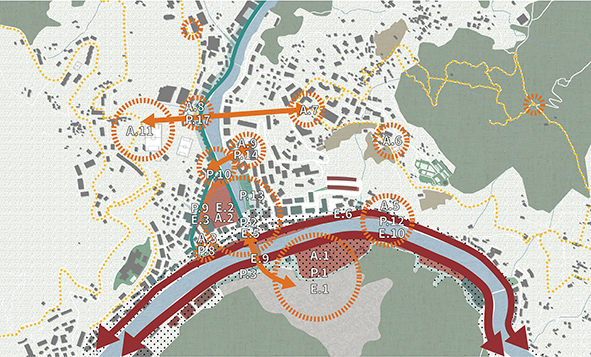Dati Open Source e Progetto Strategico per la Città Resiliente
DOI:
https://doi.org/10.19229/2464-9309/5132019Parole chiave:
open-source, data, pianificazione, resilienza urbana, strategie territorialiAbstract
Il contributo indaga l’apporto fornito dalla tecnologia dell’informazione, relativamente alla rappresentazione ed elaborazione di dati in formato open source, e crowd-sourced, ai fini del processo di pianificazione e progettazione urbana. Nell’ambito di ricerca si svolge un’analisi sperimentale all’interno della frazione genovese di Molassana comparando ed elaborando, in un unico sistema, la cartografia tradizionale fornita dai portali online della pubblica amministrazione e i dati condivisi dagli utenti sui social network e sulle piattaforme open source. Dalla complessità delle informazioni ottenute nasce una strategia territoriale sintetica multilivello, fortemente legata al contesto sia territoriale sia sociale.
Downloads
##plugins.generic.articleMetricsGraph.articlePageHeading##
Riferimenti bibliografici
Andriani, C., Fagnoni, R. and Gausa, M. (eds) (2017), Med.net3 Resili(g)ence, Intelligent Cities / Resilient Landscapes – Conference Proceedings, Papersdoc, Barcelona.
Berardi, A. (2015), La città come architettura dell’informazione ed esperienza. [Online] Available at: www.trovabile.org/articoli/architettura-informazione-citta [Accessed 19 December 2017].
Bompani, M. (2016), Il rio Geirato padre di tutte le alluvioni. [Online] Available at: ricerca.repubblica.it/repubblica/archivio/repubblica/2016/02/18/il-rio-geirato-padre-di-tutte-le-alluvioniGenova07.html [Accessed 20 January 2018].
Burry, J. R. (2007), “Mindful Spaces: Computational geometry and conceptual spaces in which designers Operate”, in International Journal of Architectural Computing, vol. 05, issue 04, pp 611-624.
Candito, C. (2016), Modelli e immagini per la rappresentazione dell’architettura, Aracne, Ariccia (RM).
Commissione europea (2012), Orientamenti in materia di buone pratiche per limitare, mitigare e compensare l’impermeabilizzazione del suolo, Ufficio delle pubblicazioni dell’Unione Europea, Lussemburgo. [Online] Available at: ec.europa.eu/environment/soil/pdf/guidelines/pub/soil_it.pdf [Accessed 20 April 2019].
MVRDV (1999), Metacity/Datatown, 010 publishers, Amsterdam.
Deutsch, R. (2015), Data-driven Design and Construction – 25 strategies for capturing, analyzing, and applying building data, John Wiley & Sons Inc., Hoboken, New Jersey.
Galli, A. (2015), “Progettazione parametrica della città attraverso gli open data”, in Urbanistica Informazioni, Special issue IX, pp.37-40.
Galli, A. (2014), “Tools and methods for parametric urbanism”, in Tedeschi, A. (ed.), AAD-Algorithm Aided Design, Le penseur, Brienza (PZ), pp. 478-481.
Gausa, M., Guallart, V., Muller, W. and Prat, R. (eds) (2003), Hicat Research Territories, Actar, Generalitat de Catalunya, GENCAT, Barcelona.
Geoportale, Regione Liguria. [Online] Available at: geoportal.regione.liguria.it [Accessed 20 January 2018].
Holling, C. S. (1973), “Resilience and Stability of Ecological Systems”, in Annual Review of Ecology and Systematics, vol. 4, pp. 1-23.
Fusero, P., Massimiano, L., Tedeschi, A. and Lepidi, S. (2013), “Parametric urbanism: A new frontier of Smart City”, in Planum, the Journal of Urbanism, n. 27, vol. 2, pp. 1-13.
Open Knowledge (2015), Open Definition 2.1. [Online] Available at: opendefinition.org [Accessed 18 January 2019].
Ratti, C. (2014a), Decoding the city: urbanism in the age of big data, Birkhauser, Basilea.
Ratti, C. (2014b), Smart city, smart citizen, Egea, Milano.
Trueheart, E. W. (2012), Building institutional capacity for data-informed decision making, vol. 3, Public Agenda, New York. [Online] Available at: www.achievingthedream.org/sites/default/files/resources/ATD_CuttingEdge_No3.pdf [Accessed 18 January 2019].
UN Global Pulse (2016), Integrating Big Data into the Monitoring and Evaluation of Development Programs. [Online] Available at: unglobalpulse.org/sites/default/files/IntegratingBigData_intoMEDP_web_UNGP.pdf [Accessed 18 January 2019].
Woods Ballard, B., Wilson Udale-Clarke, H., Illman, S., Scott, T., Ashley, R. and Kellagher, R. (2015), The SuDS Manual, CIRIA, London.

##submission.downloads##
Pubblicato
Come citare
Fascicolo
Sezione
Licenza
AGATHÓN è pubblicata sotto la licenza Creative Commons Attribution License 4.0 (CC-BY).
License scheme | Legal code
Questa licenza consente a chiunque di:
Condividere: riprodurre, distribuire, comunicare al pubblico, esporre in pubblico, rappresentare, eseguire e recitare questo materiale con qualsiasi mezzo e formato.
Modificare: remixare, trasformare il materiale e basarti su di esso per le tue opere per qualsiasi fine, anche commerciale.
Alle seguenti condizioni
Attribuzione: si deve riconoscere una menzione di paternità adeguata, fornire un link alla licenza e indicare se sono state effettuate delle modifiche; si può fare ciò in qualsiasi maniera ragionevole possibile, ma non con modalità tali da suggerire che il licenziante avalli l'utilizzatore o l'utilizzo del suo materiale.
Divieto di restrizioni aggiuntive: non si possono applicare termini legali o misure tecnologiche che impongano ad altri soggetti dei vincoli giuridici su quanto la licenza consente di fare.
Note
Non si è tenuti a rispettare i termini della licenza per quelle componenti del materiale che siano in pubblico dominio o nei casi in cui il nuovo utilizzo sia consentito da una eccezione o limitazione prevista dalla legge.
Non sono fornite garanzie. La licenza può non conferire tutte le autorizzazioni necessarie per l'utilizzo che ci si prefigge. Ad esempio, diritti di terzi come i diritti all'immagine, alla riservatezza e i diritti morali potrebbero restringere gli usi del materiale.


















































































